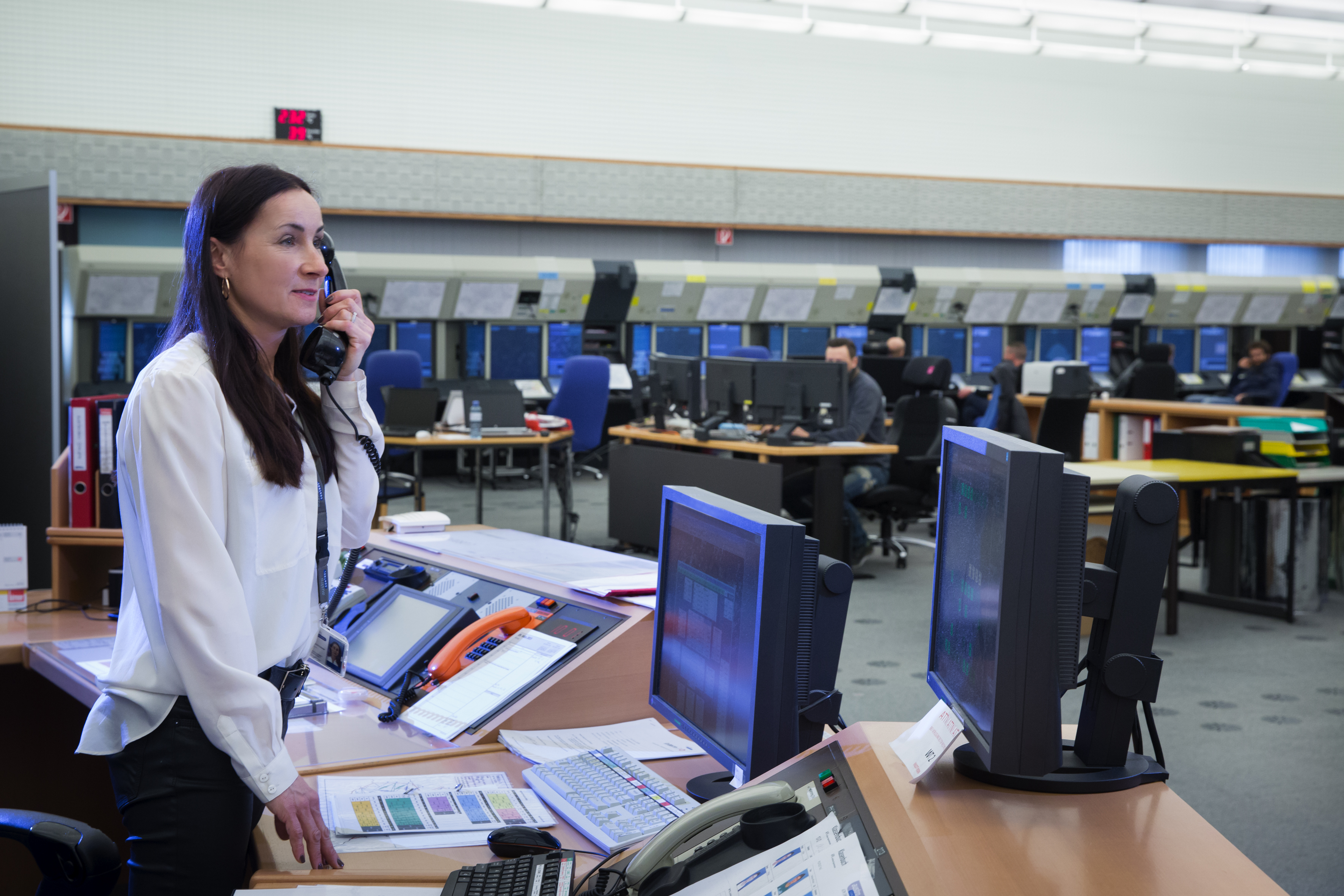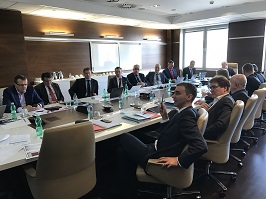FAB CE News

From April 27 this year airlines and other airspace users will benefit from safer and more on-time performance as a result of the introduction of short term air traffic flow capacity management measures (STAM) throughout FAB CE airspace.
“We expect improvements in safety and capacity,” said Ralph Michalke, ATM/Performance Manager FMP-AMC Austria at Austro Control and one of the members of the project. “Safety – in terms of fewer overloads for controllers and capacity in terms of helping us reduce the delay and the number of regulations during short-term traffic peaks.”
FAB CE FMP (Flow Management Position) operators can flexibly introduce traffic-overload prevention measures in response to the actual demand on the system by targeting individual flights with a STAM– through the use of level-capping for aircraft already airborne or introducing “take-off not before” (TONB) actions at airports. In this way, locally preferred solutions to local traffic overload challenges can be applied rather than having to resort to large-scale regulations which impact many flights.
FABCE FMPs also aim to improve the FMP coordination within the FAB to optimize STAM. The necessary coordination procedures are part of the letters of agreement of the FABCE ACCs as from 27 April 2017.
Considerable work has been taken to introduce STAMs across the FAB CE network. A live trial took place in September 2015 which was preceded by a generic safety assessment for the entire FAB. After successful completion of the live trial a decision to implement the measures across the FAB was taken. Each air navigation service provider (ANSP) additionally prepared a safety assessment for introducing STAMs at the local level for both the live trial and the implementation. Guidance and briefing materials have been prepared for flow management positions, supervisors and controllers.
Airspace users are informed of the changes via AIM (ATFCM information messages) provided via the Eurocontrol NOP portal. At a local level ANSPs can inform the airspace users via AIC or NOTAM.
This is the first phase of the STAM roll-out, based on existing tools. The Operations Subcommittee in September 2016 agreed to develop a roadmap for a future FAB CE wide implementation of STAMs as part of work to improving Airspace Management (ASM) processes and Dynamic Airspace Management (DAM) (See FAB CE Newsletter: Autumn 2016). STAM phase two will require the availability of new tools which will allow for better monitoring and complexity handling. These tools are currently under developing within the SESAR JU research portfolio; the strategic deployment of STAMs throughout the Single European Sky is part of the Single European Sky (SES) Deployment Programme.
 FAB CE is now on Twitter. Get all the latest news and stay up-to-date on all the current developments.
FAB CE is now on Twitter. Get all the latest news and stay up-to-date on all the current developments.
The First FAB CE Social Dialogue 2017 will take place on the 18th and 19th of May 2017 in LPS premises, Bratislava.
South East Common Sky Initiative (SECSI) - Memorandum of Cooperation signed
Representatives from five ANSPs signed a memorandum of cooperation during the World ATM Congress in Madrid aimed towards merging the two Free Route Airspaces SAXFRA (Slovenian Austrian Cross-Border Free Route Airspace) and SEAFRA (South-East Axis Free Route Airspace).
SAXFRA (Austro Control and Slovenia Control) and SEAFRA (BHANSA, Croatia Control and SMATSA) are two crucial cross-border initiatives contributing significantly to the efficient flow of air traffic along the vital South-East Axis. Each project has shown itself to be working out very well, but in line with the goals of Single European Sky a merging of those two airspaces will generate even greater benefits.
cross-border initiatives contributing significantly to the efficient flow of air traffic along the vital South-East Axis. Each project has shown itself to be working out very well, but in line with the goals of Single European Sky a merging of those two airspaces will generate even greater benefits.
The South East Common Sky Initiative will strengthen the South East Axis by offering the shortest route options between Central and South Europe, including the flows to Turkey and further to the Middle East. This initiative not only works towards achieving the goals of the European Commission regarding the implementation of Free Route across Europe but also fulfils airspace users’ requests for having multiple route options available for the same city pair. The cooperation of SAXFRA and SEAFRA will produce one of the largest cross-border Free Route airspaces in Europe and is a significant step towards achieving a common European Free Route airspace (FRA) by 2022.
“In line with the goals of Single European Sky this is the next significant step towards Free Route airspace across all of Europe. The South East Common Sky Initiative will benefit both the airlines and passengers in reducing fuel consumption as well as the travel time”, said Austro Control CEO Heinz Sommerbauer in Madrid.
“If there is a common goal and willingness to cooperate, we can achieve great things. The South East Common Sky Initiative is a perfect example for that. Five ANSPs working together towards improving the flow of air traffic across Europe”, said Austro Control COO Thomas Hoffmann.
“As a logical continuation of an excellent cross-border cooperation through the SAXFRA and SEAFRA free route projects, SECSI is not only in line with the Single European Sky initiative but offers even more increased efficiency and capacity over Central and South East Europe”, said BHANSA CEO, Davorin Primorac.
“The SECSI Free Route airspace is a step forward after the two successfully completed FRA projects, SAXFRA and SEAFRA. I am sure that the five ANSPs will demonstrate excellent cooperation for the benefit of the airspace users to save thousands of tons of fuel per year; moreover, the citizens of the six states will be exposed to significantly decreased emissions of CO2 and NOx. I believe the airspace users will recognize the benefits of FRA in this region as well as the environmental achievements” said Croatia Control CEO Dragan Bilać.
“The South East Common Sky Initiative is another major step towards the needed ANSP collaboration in making a seamless European Sky a reality and reducing the future environmental footprint” said Slovenia Control CEO Franc Željko Županič.
“A positive attitude, professionalism and devotion, demonstrated in SEAFRA and SAXFRA projected by all parties involved, guarantees the success of the South East Common Sky Initiative. I am absolutely confident that this important Free Route Airspace project in the region and Europe will deliver more significant savings to our users”, said SMATSA CEO Radojica Rovčanin.
The significance of the South East Common Sky Initiative was also stressed by Joe Sultana, Director Network Manager Eurocontrol:
“Following the successful implementation of the SAXFRA and SEAFRA initiatives, the South East Europe Common Sky Initiative is an excellent example of how cross-border Free Route Airspace implementation progresses in Europe in complex airspace. The detailed and innovative work conducted by the five ANSPs in close coordination with the Network Manager makes this initiative a tangible example of how the European ATM network can be optimised. It opens significant opportunities for further airspace optimisation in Central and South East Europe with similar neighboring initiatives”.

On March 2nd the FAB CE CEO Committee was held in Bratislava.
Among the topics discussed were a report by the Program Manager including an update on the status of FCE activities as well as on the Gate One FRA. Additional topics included the FCE Annual Plan 2017 and CEF FRA –Validation activities. Also on the agenda PR and Government Affairs Strategy.
Following the night implementation in April 2015, three ANSPs (SMATSA, Croatia Control and BHANSA) responsible for the ANS provision in the airspace of four States – Serbia, Montenegro, Croatia and Bosnia and Herzegovina as of December 8th have offered the airspace users H24/7 possibility to plan and execute flights free of fragmentation by state or AoR borders, by implementing the cross-border Free Route Airspace (FRA) – South-East Axis FRA (SEAFRA) - above FL325.
This is the first European FRA concept implemented over the territories of four states, two of which are members of FAB CE (Croatia and Bosnia and Herzegovina) with Serbia and Montenegro which are not a part of the FAB initiative, proving that such cooperation is possible, and can be of benefit to all stakeholders.
The idea of such a large-scale FRA was initiated by ATM experts of the ANSPs responsible for ANS provision in different states, with a common goal of improving ATS (Air Traffic Service) safety and efficiency as well as environmental protection by reducing fuel, CO2 and fuel NOx emissions.
It is important to point out that the SEAFRA actions were taken in line with the Regulation 716/2014, i.e. 5 years prior to the date of January the 1st 2022 for which the unlimited free use of airspace over 9.000 m across Europe is planned.
This project is one of the key improvements within the EU initiative on establishing the Single European Sky, regardless of the state borders or even FAB borders, aiming to enhance safety and efficiency, and to increase capacity of air traffic in Europe.
Page 26 of 41
